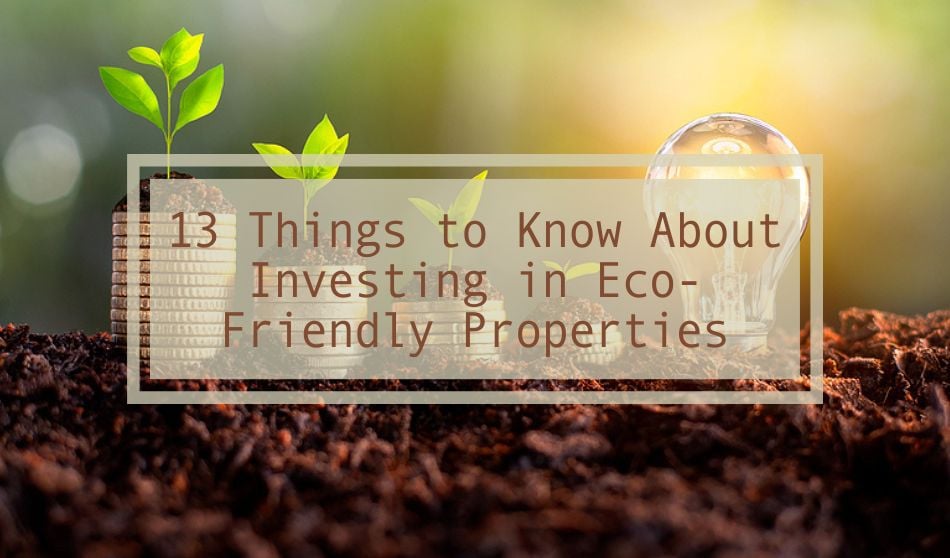
Investing in eco-friendly properties is one real estate trend that is here to stay, and will offer ROI long-term. If you’re interested in eco-friendly investing, understanding the ins-and-outs can ensure you make the best choices for your market and environmental impact.
Trends in real estate come and go — remember harvest gold kitchen appliances? However, one trend that is here to stay is eco-friendly investing. Environmentally conscious potential tenants and buyers seek energy-efficient features that don’t cause harm. This opens up a world of possibilities for investors looking to go green in their real estate portfolio — in more ways than one!
If this sounds like you, here are 13 things to know about investing in eco-friendly properties.
What is eco-friendly investing?
Eco-friendly real estate investing, also called sustainable real estate development, focuses on buying, building, or developing properties to minimize their negative environmental impact.
This means:
- Utilizing sustainable building materials
- Minimizing the building’s carbon footprint
- Incorporating environmentally friendly design principles (such as passive design or design that utilizes the surrounding landscape)
What does this look like? Eco-friendly properties:
- Aim for net-zero or net-neutral carbon emissions in completed renovations
- Use low-energy fixtures and fittings
- Incorporate passive design and green space
All of these aspects work together to create a building that is healthier for the planet and all of the people on it. Eco-friendly buildings aren’t confined to single-family dwellings or workplaces. Even industrial facilities and warehouses are getting in on the idea of smarter development for a cleaner environment.
13 Things to Know About Investing in Eco-Friendly Properties
Everybody’s Doing It
This is not entirely true, of course, but with rising concerns about climate change and its effects on the environment, more investors are looking to invest in properties in a way that minimizes their environmental impact.
Demand is Increasing
Growing environmental consciousness — and a desire to do better when it comes to the impact of development on the planet — means that there may be a higher demand for eco-friendly properties. If demand increases before the supply can catch up, the potential for a higher return on investment (ROI) also increases.
There are Government Incentives for Investors
Many investors are aware of programs for traditional investments, but many federal, state, and local governments are adding to that with specific incentives for eco-friendly investment opportunities. This might include tax credits, grants, or subsidies for new builds or retrofitting existing structures.
Eco-friendly Investment Properties May Cost More
Eco-friendly investments tend to cost more in terms of the initial investment. The cost of installing energy-efficient systems and building with sustainable materials is higher than standard building materials. The good news? These costs are mostly front-loaded and will level out over time.
High Initial Cost but Lower Operating Expenses
Yes, energy-efficient windows made of sustainable materials can indeed cost almost twice as much as a traditional window. But these same windows can result in sharply decreased energy bills over time.
The same holds true for adding features like high-quality insulation and a more efficient HVAC system. Not only do these result in significant energy savings, but the quality also translates into better longevity and less maintenance.
Meeting Certain Standards Can Earn You More Money
Even if you shell out for sustainable flooring, more insulation, high-quality systems, solar panels, and better windows, your property is not quite across the eco-friendly finish line until it’s certified.
There are several standards and certifications to consider.
- LEED (Leadership in Energy and Environmental Design)
- BREEAM (Building Research Establishment Environmental Assessment Method)
- ENERGY STAR (primarily for appliances and windows)
If you can build or renovate to these standards, you may be able to rent your property to eco-conscious tenants for above-market rates.
Green Building Materials Are More Widely Available
Finding environmentally friendly building materials used to be challenging, but they are now more widely available. Better yet, prices have come down to make these materials accessible to investors with just a property or two.
Eco-Friendly Properties May Sell Better
Do these improvements pay off when it’s time to sell a property? Some studies say yes. A Freddie Mac paper found that top-rated energy-efficient homes sold for 3% to 5% more than homes with just a few eco-improvements, and all homes with environmentally conscious renovations or construction sold for 2.7% more than unimproved homes.
In terms of dollars, a 2019 study from the National Association of Home Builders found that energy-efficient homes sell for about $5,000 more than comparable homes.
Small Improvements Can Make a Big Difference
You don’t have to completely overhaul your investment property to improve its carbon footprint. If you aren’t looking to renovate down to the studs, consider the following:
- Caulking and insulating exterior windows
- Swapping out old appliances for energy-efficient new ones
- Using interior paints with no volatile organic compound (VOC) emissions
- Staying up to date with HVAC and water heater maintenance for better functionality
- Adding all LED lightbulbs
- Increasing attic insulation
Eco-friendly Investing + Technology = Perfect Fit
If you’re an investor who gets excited about gadgets, eco-friendly investing is a good fit. From materials designed by robots to entire 3D-printed homes, the tech space is well represented in environmentally conscious investing.
Tech innovations also include “smart” tools that help regulate a building’s temperature and can even be programmed to lighten and darken windows on a schedule or from a mobile device. These features incorporate technological advancements for a cleaner, greener, and more efficient investment.
Marketing is Easy
There is no need to spin the impacts and benefits of an eco-friendly investment property. The benefits of living and working in an energy-efficient environment are well-known. Investors would do well to highlight how proper ventilation, airflow, and green space affect physical and mental health in their marketing materials. The same goes for homeowners looking to list their own environmentally friendly house.
Solar is Just One Option
Rows of solar panels on a roof used to be the tell-tale sign of a home that was “going green,” but these days, there are many other options for lowering your investment’s carbon footprint. You might explore wind or water energy, building-wide water recycling, and green roofing as other options for eco-friendly changes or additions to your investment.
Investing in Eco-Friendly Properties is Long Term
Because the upfront costs can be off-putting, realizing that this is not a get-rich-quick proposition is essential. There is no guarantee you’ll profit from your real estate investment, but it’s especially important to remember that it may take a while to recoup your investment.
The good news? Taking care of the environment is a trend that is always in style. In fact, this type of investment may become the new normal as the impacts of climate change highlight the need to invest, renovate, and build in a more environmentally conscious way.





